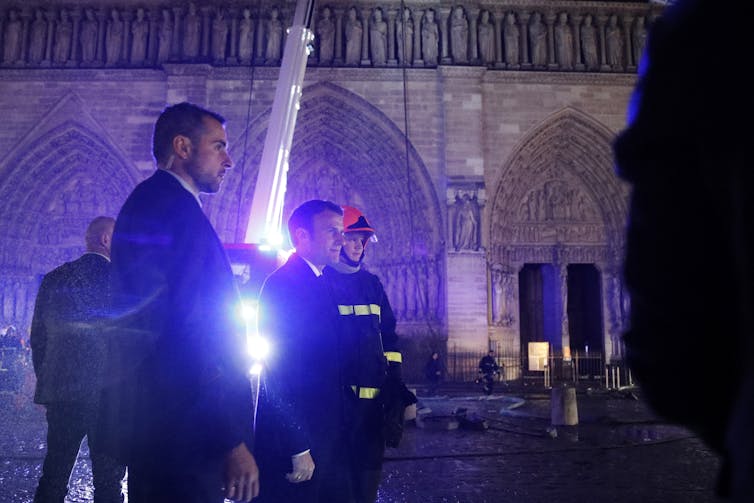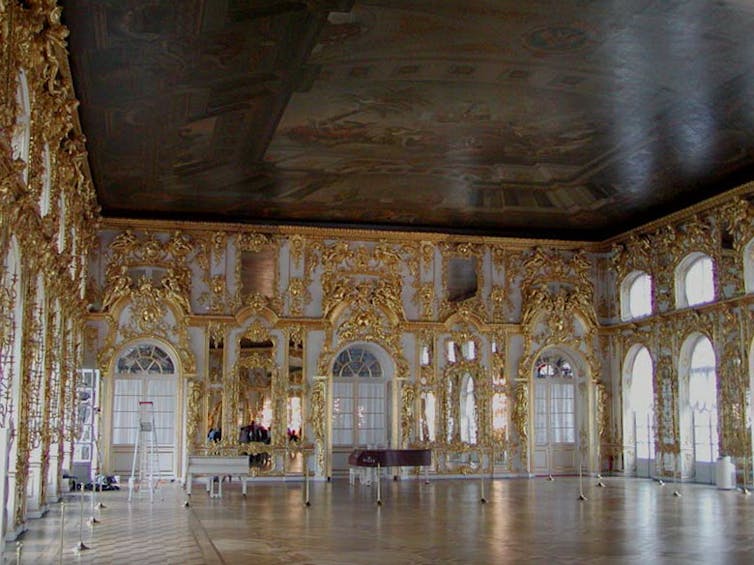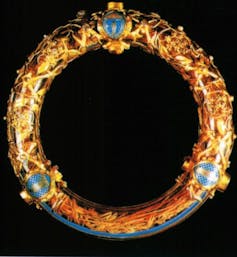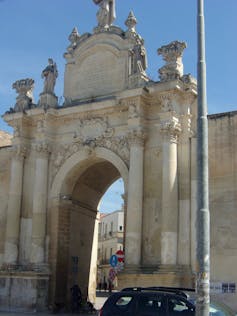Don't despair about Notre Dame
- Written by Claire Smith, Professor of Archaeology, College of Humanities, Arts and Social Sciences, Flinders University
The destruction of Notre Dame cathedral is lamentable. A wonderful icon has been largely destroyed by fire. However, we should not despair.
Part of the reason this loss is so upsetting is because we are immersed in a Western way of thinking that equates authenticity with preserving the original materials used to create an object or building.
But not all societies think like this. Some have quite different notions of what is authentic. Iconic buildings such as the Catherine Palace in Russia and Japan’s historic monuments of Ancient Nara have been successfully restored, sometimes after great damage, and are today appreciated by millions of people.
 French President Emmanuel Macron speaks with firemen at the cathedral.
Yoan Valat/EPA
French President Emmanuel Macron speaks with firemen at the cathedral.
Yoan Valat/EPA
The preamble to the International Charter for the Conservation and Restoration of Monuments and Sites, (the Venice Charter 1964), states that, “Imbued with a message from the past, the historic monuments of generations of people remain to the present day as living witnesses of their age-old traditions … It is our duty to hand them on in the full richness of their authenticity”.
But in our diverse world, the definition and assessment of authenticity is a complex matter. The World Heritage Convention guidelines state that properties may be understood to meet the conditions of authenticity if their cultural values “are truthfully and credibly expressed”.
Accordingly, a building’s authenticity is determined in relation to its location and setting, use and function, spirit and feeling, and well as form and materials.
 Japan’s NaraTodaiji.
Wikimedia
Japan’s NaraTodaiji.
Wikimedia
Japan’s historic monuments of Ancient Nara - comprised of Buddhist temples, Shinto shrines and the excavated remains of the great Imperial Palace – provide important insights into the nation’s capital during the 8th century. These buildings are not less authentic because they were extensively restored after the enactment of the Ancient Shrines and Temples Preservation Law in 1897.
A palace gutted
The Catherine Palace at Tsarskoe Selo (Pushkin), south of Petersburg, was gutted during the second world war. When Russian people first saw the damage, they must have despaired.
Nevertheless, the government provided the resources to allow room-by-room restorations. The restoration of the Amber Room, one of the most famous palace interiors of the 18th century, is a triumph.
Panels that had been looted by the Nazis were recreated over 25 years with an investment of $11 million. Today, the Palace is fully restored, a spectacular icon that attracts millions of visitors a year.
 The Catherine Palace ballroom.
Wikimedia
The Catherine Palace ballroom.
Wikimedia
What about the relics and artworks?
The fire at Notre Dame has endangered a vast collection of Christian relics and artworks housed within the building and on its grounds, including the crown of thorns. First responders saved many, but not all, objects. We do not yet know which ones have survived.
Does the argument regarding authenticity also apply to these relics and precious artworks? Well, yes and no.
 Couronne d epines, Crown of Thorns, Notre Dame Paris.
Couronne d epines, Crown of Thorns, Notre Dame Paris.
There are two scenarios. The first is that the relics and artworks are partially damaged by fire, smoke and falling building materials. Within this scenario, the focus will be on restoration - and marvellous things can occur in the realm of materials conservation.
The second scenario is that relics or artworks are virtually, or entirely, destroyed. Within this scenario, the artworks can only be replicated, not restored. Such replication would have a precarious tie to the original works.
From the viewpoint of restoration, there is a crucial difference between portable and non-portable artefacts. Other than those that were part of the fabric of the building, the relics and artworks were not made on site. The building itself, however, has a continuity of identity and function through being located within a specific landscape.
What now for Notre Dame?
One way forward is to use the Venice Charter (1964) to guide restoration. This would mean that the new materials used in preserving this historic structure would be kept distinguishable from the original construction.
 Conservation of the city gate in Lecce, Italy, undertaken according to the Venice Charter.
Gary Jackson
Conservation of the city gate in Lecce, Italy, undertaken according to the Venice Charter.
Gary Jackson
Another way forward would be to restore the structure in a similar manner to that of Catherine I’s palace, in which an untutored eye finds it difficult to distinguish between the old and new parts of the structure. Given the extent of the damage, this would be the more aesthetically pleasing and less jarring approach.
Unlike other places of deep cultural significance, which may be destroyed forever due to commercial development, Notre Dame can be rebuilt. With modern technology, it is entirely possible for the cathedral to be recreated with near-accuracy to the original. We can do this and keep the original building’s spirit and feeling.
Authors: Claire Smith, Professor of Archaeology, College of Humanities, Arts and Social Sciences, Flinders University





